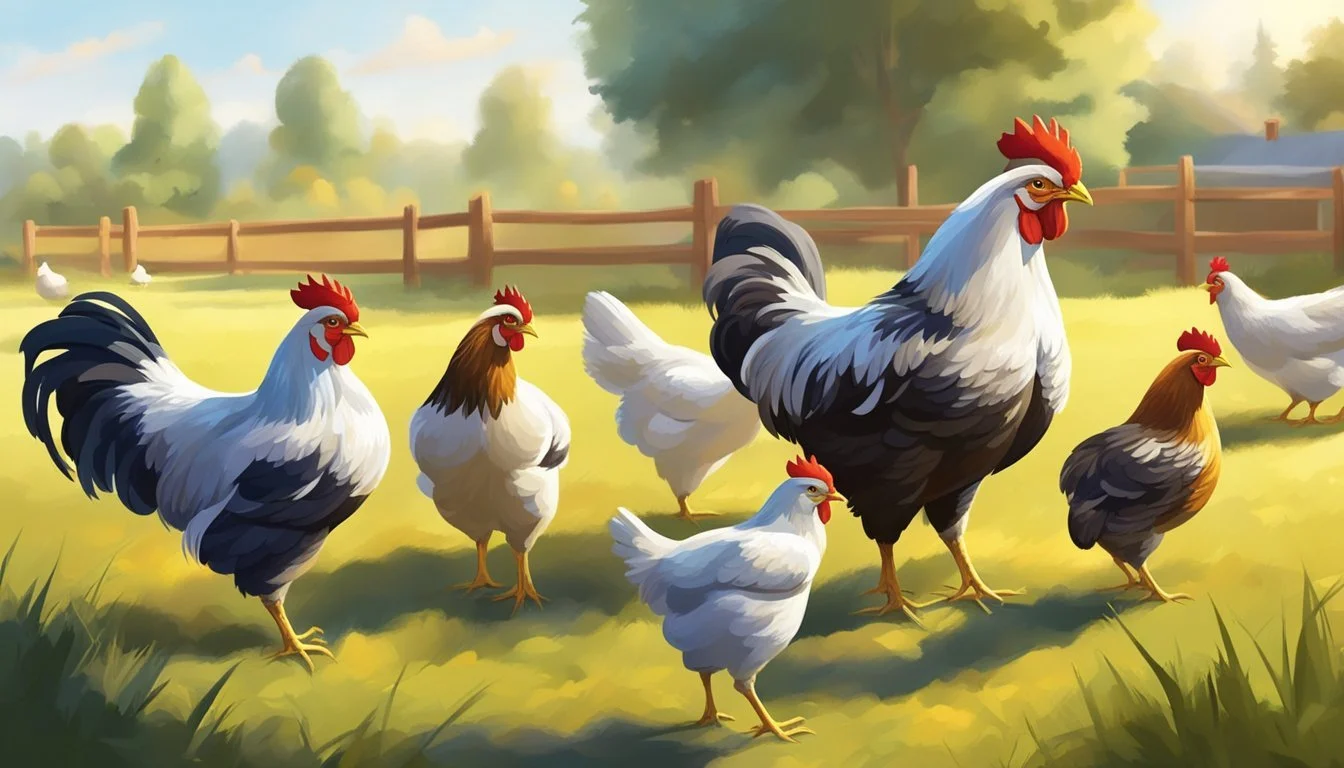How do I integrate different age groups in my flock
A Guide to Mixed-Age Integration
Integrating different age groups into an existing chicken flock requires careful planning and consideration to reduce stress for both the newcomer birds and the established members. It is crucial to take into account the social hierarchies that exist within poultry groups, commonly referred to as the "pecking order." To ensure a smooth transition, the playpen method can be an effective strategy, where new chickens are introduced to the flock in a way that allows them to see and interact with each other without physical contact initially. This period of visual acquaintance helps both groups to get used to each other's presence in a safe and controlled environment.
Adjusting feeding habits for integrating new chickens may also be necessary, especially if the incoming birds are of a different age or size, to ensure that all chickens receive the required nutrition. Additionally, it's beneficial to observe the behavior of the flock during this time to identify and address any signs of aggression or bullying swiftly. The integration process is gradual and may require adjustments based on the chickens' responses to each other to create a harmonious flock.
Understanding Flock Dynamics
Integrating different age groups into a flock requires an understanding of the flock's social structure and the varying behaviors displayed by chickens at different life stages.
The Pecking Order
The pecking order is a hierarchical system established by chickens to maintain order and stability within a flock. This social structure dictates access to food, nesting spots, and other resources. Dominant birds, usually older hens or roosters, occupy the top positions and exert control over docile birds by pecking, which can range from gentle reminders of their status to more aggressive scuffles. Understanding and respecting this hierarchy is crucial when introducing new members.
Age Groups and Their Behaviors
Chickens of different ages display distinct behaviors that must be considered during integration. Chicks are vulnerable and need protection, whereas adolescent birds are often curious but lack social status. Adult hens and roosters may display aggression when their territory is challenged by newcomers. The established flock can exhibit bullying towards younger or new birds. Age groups should be introduced carefully to mitigate aggression and allow time for the newcomers to find their place within the pecking order without causing excessive disruption.
Preparation for Integration
When integrating different age groups into a flock, it's crucial to prioritize their health and safety. This section delineates the essential steps to prepare for a smooth integration process.
Quarantine Measures
Quarantine is a critical first step for introducing new birds into an existing flock to prevent the potential spread of diseases, parasites, and illnesses. Newcomers should be quarantined for at least 14-30 days. During this period, one should observe the birds for signs of illness, lice, or mites, and only those confirmed to be disease-free should proceed to introduction.
Creating a Unified Environment
Creating a safe and unified environment inside the coop is necessary to minimize stress and aggressive behavior. Design the space so that both new and existing chickens have access to ample resources. Utilize chicken wire or hardware cloth to create a barrier that allows visual contact while keeping the groups separated, thus reducing the risk of injury from dominant birds.
Introducing New Birds Safely
Gradually introducing new birds involves placing them within the coop using a secure but visible enclosure to allow for safe acclimatization. This could be a large cage or a partitioned area that offers protection yet enables interaction. It's beneficial to provide a first aid kit within reach in case of any unexpected injuries. For free-range flocks, supervised time together in a common area helps in establishing familiarity without the threat of predators.
Managing the Integration Process
When integrating different age groups into a backyard chicken flock, it’s important to manage the process with care to prevent injuries and ensure all chickens become comfortable with each other. A structured approach with clear steps can help in smoothly integrating chickens.
Gradual Introductions
To begin the integration, gradual introductions are crucial. This involves allowing chickens to see and hear each other without direct physical contact. One can use a method like the Playpen Method, providing a safe zone for new birds while maintaining visual contact. This step should continue for a minimum of a few days to a week, giving both parties time to adjust to the presence of the other.
Duration: Few days to a week
Method: Visual contact without physical access
Objective: Familiarization in a safe environment
Monitoring Flock Interactions
Once initial familiarization is complete, the next phase involves closer interactions under supervision. This can be during controlled free-range introductions or in a neutral territory. The goal is to observe chicken behavior and ensure there are no signs of aggression. It's important to provide plenty of room for the chickens to interact without feeling crowded. If aggression occurs, it’s vital to intervene to protect the chickens from potential injuries.
Observation: Look for signs of bullying or stress
Intervention: Separate aggressive birds if necessary
Environment: Open space with escape routes
Dealing With Aggression
Aggression is a common issue when integrating chickens. To deal with aggression, one might need an additional cage or segregated area to temporarily isolate an aggressor or a bullied chicken. Offering treats can also be a useful distraction to reduce tension. In the case of injuries, isolation and proper care are necessary until the chicken recovers. Consistent monitoring during the integration process is essential for a peaceful and well-integrated flock.
Strategy: Temporary segregation, providing distractions
Care: Treat any injuries immediately
Tools: Use a cage or separate area for protection
By following these structured steps and being prepared to intervene when necessary, flock owners can ensure a smoother and safer integration of chickens of different ages into one community.
Sustaining a Harmonious Flock
Successful integration of different age groups in a flock hinges on ensuring stress is minimized and the needs of all birds are met. A careful balance of resources and environment plays a crucial role in maintaining a peaceful coexistence among the chickens.
Maintaining Ample Resources
One of the fundamental aspects of sustaining a harmonious flock is the provision of ample resources to alleviate competition and reduce stress. Water should always be abundant, with multiple stations to prevent crowding and ensure that young birds and bantams have access without intimidation from older flock members. Similarly, offering various feeding stations stocked with appropriate treats allows birds to eat without conflict. Essential nutrients help prevent issues such as scaly leg mites, and the variety distracts birds from pecking at each other.
Providing Adequate Space and Shelter
Space is another critical factor; overcrowding can lead to stress and increased aggression, escalating into blood-shedding altercations. Plenty of room is necessary for chickens to establish their territories and personal space. Whether in a run or free-range situation, providing several hiding places can help lower-tier birds escape confrontations. Shelter should be sufficient not only to protect from the elements but also to give broody hens or segregated birds a safe haven. Adequate space must be allocated to the birds at all times, so multiple coops or segregated areas may be necessary during introduction periods.
Special Considerations for Different Ages
When integrating different age groups into a flock, it's critical to consider the varied needs and behaviors of chickens at each stage of life. This ensures a seamless introduction and maintains a harmonious environment within the coop.
Integrating Baby Chicks
Baby chicks require a warm and secure environment, especially during their first weeks of life. It's essential to maintain an isolated area within the brooder that's equipped with heat lamps, ensuring the temperature is kept between 90-95 degrees Fahrenheit. Gradually reduce the heat by 5 degrees each week until they acclimate to the ambient temperature. Isolation prevents older birds from injuring the chicks—physical barriers in the run allow the two groups to see each other without direct contact—facilitating a stress-free introduction.
Mixing Young and Old Birds
The integration of young birds with older ones demands caution to prevent injuries and undue stress. Introduce them gradually during free-range time under supervision, when the older birds are less territorial. Ensure younger chickens have space to retreat if necessary. Establish multiple feeding and watering spots to reduce competition and promote a peaceful coexistence. Observe the flock's hierarchy and intervene if dominant birds become overly aggressive.
Managing Broody Hens and Roosters
Broody hens and roosters add complexity to flock dynamics. If a single chicken becomes broody and protective of her nest, allocate a separate space for her to prevent disruption and stress to the rest of the flock. With roosters, especially bantam breeds that are known for their assertiveness, introduce new birds with careful oversight to mitigate territorial aggression. Night-time introductions may be less stressful, as birds are more placid and less likely to engage in confrontational behavior.
Long-Term Strategies for Flock Expansion
When planning for flock expansion, the long-term integration of different age groups requires thoughtful strategies that foster a culture of acceptance and ensure consistent observation and management.
Incubating a Culture of Acceptance
Creating an environment conducive to the acceptance of new chickens into an existing flock begins with understanding chicken math and personalities. Introducing new chickens should coincide with the flock's natural inclination to explore and establish a pecking order. To incubate a culture of acceptance, one must start with separated enclosures that allow for visual contact while raising chickens. This method gradually familiarizes old and new members without immediate physical interaction, hence reducing potential bullying and stress.
Time and patience are key as this process allows the flock's dynamic to adapt naturally.
During integration, ensure that all birds have access to ample food and water to avoid competition and possible aggression.
Continual Observation and Adjustment
The integration phase requires vigilant observation. One should monitor the interactions to adjust the living conditions accordingly, ensuring that all chickens feel comfortable and safe.
Enclosures should be spacious to allow for exploration and escape from potential aggressors.
Watch for signs of bullying or distress and be ready to provide additional comfortable spaces or barriers as needed.
Regular checks for predators and parasites are also crucial for the chickens' safety and welfare.
Through dedicated time and attention to these strategies, flock expansion becomes a smooth and successful part of managing a healthy and accepting chicken community.
Conclusion
Successful flock integration calls for patience and attentiveness to chicken behavior and flock dynamics. When introducing new members, it's important to prioritize a period of isolation, which serves as a quarantine to protect against disease spread and to monitor health. Following this, a "see but not touch" phase allows both new and existing chickens to become accustomed to each other while minimizing stress, which can be achieved using fences or crates.
Next, supervised periods of interaction help in assessing the flock's behavior towards the newcomers. It is advisable to introduce younger or smaller birds during the evening when the birds are less active, leveraging the calming effect of nighttime to ease the integration.
The goal is always peaceful cohabitation, which may require strategic intervention at times. Identifying and separating bullies or providing escape routes for the new chickens can prevent injuries and promote harmony within the flock.
Finally, ensuring equal access to food, water, and perching space will help mitigate competition and encourage acceptance. New additions should be introduced over time, observing the flock's reactions and adjusting the approach as necessary. The integration of different age groups can be seamless if these steps are mindfully undertaken and the chickens' welfare is always at the forefront.




